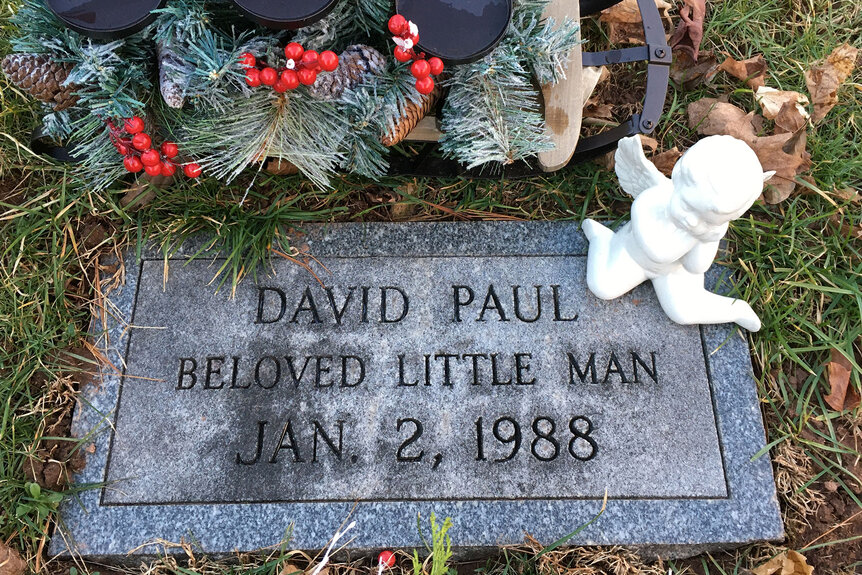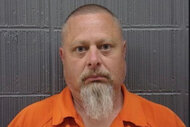Create a free profile to get unlimited access to exclusive videos, breaking news, sweepstakes, and more!
DNA Tech Leads To Mother Of ‘Beloved Little Man,' Who Was Found Abandoned And Frozen To Death 32 Years Ago, Cops Say
Karen Roche told police she had been waiting 32 years for them to knock on her door after they'd linked her to mystery infant David Paul, who died of exposure in 1988.

The tiny tombstone of David Paul reads “beloved little man.”
David, an infant who froze to death hours after being born, was found abandoned underneath a tree in a Connecticut parking lot on a frigid winter morning in January 1988. At the time — and for decades thereafter — police were unable to identify the child’s parents or determine why he had been discarded.
Police named the child — and for more than 30 years, have held annual graveside memorials on the anniversary of the child’s tragic and puzzling death.
But on Jan. 2 — the 32nd anniversary of the baby John Doe’s passing — detectives identified the mother of the mystery child after years of intensive forensic investigation. DNA technology pinpointed relatives of the newborn in or near South Meriden. One of the possible family members, police said, was Karen Roche.
Investigators “decided to knock on the door cold to see what she had to say,” South Meriden Police Chief Jeffry Cossette told Oxygen.com.
As soon as Roche answered the door, her jaw dropped, Cossette said.
“They could see the look on her face that they were onto something,” he said. “The woman indicated she had been waiting 32 years for the police to knock on her door.”
On Jan. 8, a DNA test confirmed Roche was David Paul’s mother, police said.
The woman admitted she had hidden her pregnancy from the father, and confessed to delivering the newborn at home around 5:30 a.m. on Dec. 28, 1988. Roughly an hour after giving birth, the troubled mother said she stashed David at the foot of a tree in a factory parking lot. She claimed to have phoned a local fire department to report the location of the vulnerable infant.
However, roughly a week passed before the newborn was recovered by law enforcement. Cossette confirmed a call had been placed on the evening of the child’s death, but noted the caller had provided scant details. The police chief said the caller, who he suspects was Roche, directed authorities to the parking lot, but didn’t specify what they should be looking for — and didn’t disclose she had deserted a baby. The tree was adjacent to the parking lot, but wasn’t actually visible from where police initially searched, he said.
“If she would’ve said it was a baby, there would've been thousands of troops out there searching,” Cossette explained.
Roche, then 25, panicked on the icy morning she dumped her child in the parking lot, according to Cossette. He described her as “remorseful.” The woman, now 56, claimed to have felt lifelong guilt — and has never had children because of what “she did to this child.”
“Every day she would think about it,” Cossette added.
Cossette, who said Roche has been honest with investigators, doesn’t anticipate charges will be pressed against her. Connecticut has a 20-year statute of limitations on manslaughter charges, he said. Additionally, since Roche supposedly attempted to alert authorities to the incident, Cossette said it would be difficult to prove intent on any charges.
Nevertheless, he called Roche’s actions “tragic.”
“There was a lot of other ways to have the baby taken care of rather to have the baby die at the base of a tree,” he said. “She could have been more specific. She could have knocked on anybody’s door. She could’ve left it at a police or fire station.”
Without DNA technology, Cossette said, the case would still be cold. The police chief credited Dr. Colleen Fitzpatrick, a renowned DNA scientist and forensic genealogist, as the driving force behind cracking the case.
Fitzpatrick, a former NASA contractor, and founder of IdentiFinders International, has worked hundreds of cold cases, including other high profile genealogical projects involving Abraham Lincoln and the Unknown Child on the Titanic.
The California-based scientist said she first learned of South Meriden’s Baby John Doe in 2012. Not long after, she began her own independent work on the case. In 2014, she obtained the "Y" DNA profile of David Paul from the Meriden Police Department. In 2017, along with Dr. Margaret Press, Fitzpatrick developed a way to create Ancestry.com-like data from the DNA on the case. Fitzpatrick's efforts eventually led to Roche.
“When we uploaded it to GEDmatch, we obtained a list of relatives (DNA cousins) of the mom and the baby,” Fitzpatrick told Oxygen.com. "This allowed her team to begin constructing the unknown child’s family tree. Suppose I know your second cousin but I don’t know who you are. But I know you’re a certain age, and that you live in a certain area. I can take your cousin’s family tree, build it out, and look for you.”
For Cossette, solving the Baby John Doe case was personal. The law enforcement veteran, who worked the case as a rookie detective in his 20s, said the unsolved mystery dogged him throughout his career. Solving it now, months ahead of his own planned retirement from the force, he said, is “fulfilling.”
"It's emotional to close the case," Cossette said. "It makes it personal when something like this happens."























